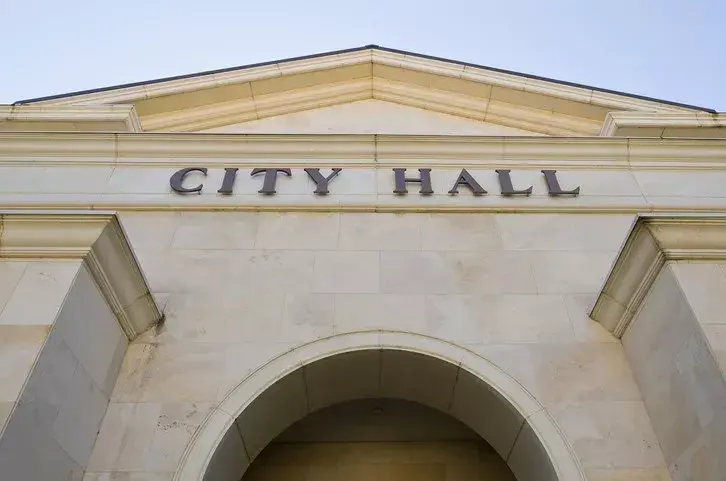The primary functions of U.S. local government and why transparency matters

It’s Monday morning and Rhonda is ready for work. As she leaves her house to walk to the bus stop, she remembers it’s garbage collection day. She drags her trash and recycling cans to the front of her driveway.
She hops onto the public transit bus. As she settles in her seat, Rhonda pulls her library book out of her tote bag. She needs to finish it before her library book club meets again. She’s quickly engrossed in her reading and doesn’t notice as the bus drives its regular route by the water treatment plant.
She’s jostled when the bus stops unexpectedly, allowing a fire truck and ambulance to rush by, sirens screaming. She looks up from her book to notice a new playground in the community park she frequents. She wonders why the city council spent money on the new playground when the previous one seemed fine to her.
On her lunch break at work, she searches for a mention of playgrounds in the minutes of the past few council meetings. The old playground did not meet new accessibility standards. The new one allowed children of differing abilities to play on the equipment. There was even a swing that could accommodate a wheelchair. Rhonda was satisfied that taxpayer money was well spent. She returned to work glad she could easily find the information she needed.
While federal government elections and other actions receive most of the media attention, local governments have a greater impact on individuals. It’s easy for the average person to take local government services for granted or not understand how or why decisions are made.
Local governments build trust within their communities by functioning as transparently as possible.
What are the primary functions of local governments?
The 10th Amendment grants all powers not given to the federal government back to the people by way of state and local government. In most cases, local governments were the first forms of government in a region and were created before state and federal governments existed.
Local governments have two basic functions, according to the Center for the Study of Federalism: “To meet needs and solve problems of a local nature and to deliver such basic life amenity services as water, sanitation, streets, fire, police, and citizen protection.”
According to the 2022 Census of Governments, there are 90,837 local government units in the U.S. Of these, 38,779 are general-purpose local governments, which include county, municipal and township governments. School districts and special district governments make up the rest.
Education tends to be one of the largest line items in local government. In many cases, elementary and secondary education accounts for 39 percent of direct local government spending, according to the Urban Institute.
Boost trust and civic engagement
Find out how technology can fuel and support transparency while increasing community engagement and inclusivity.
Get the guide!Local government structures
Most local governments divide their jurisdictions into two levels including county and municipal governments. Some states divide their county governments into townships. It's common in New England for towns to manage the local government functions, leaving perfunctory capacity for the county level, such as census taking.
At the municipal level, the size and culture of the community are factors in the labeling of areas cities, towns, villages, or boroughs. In some places, the city and county combine to form a consolidated city-county jurisdiction.
State governments make decisions about the power and authority that local governments and municipalities have. In municipal or local governments, the citizens directly elect their public officials.
How local governments use departments to manage community functions
Many residents don’t think about or even realize how many services their local government provides: education, water and sewage treatment, parks and libraries, buses and other forms of public transportation, garbage collection, and fire and rescue services.
Local and municipal governments manage many facets of governing their communities. Communities' infrastructures are typically divided into many departments to make their duties manageable. Typical departments that you might see in local government include:
- Police departments
- Fire departments
- Emergency Medical Services
- Libraries
- Public works departments
- Building and zoning departments
- Schools
- Parks and Recreation
- Municipal courts
- Streets and sanitation departments
- Roads and streets departments
- Public safety
- Water sanitation
- Senior citizen programs
- Cemeteries
- Housing
- Community development
- Environmental protection
Smaller communities may share some services such as libraries, schools, police, and fire departments. As needed, local governments can form additional committees and sub-committees to address various community problems or needs.
Depending on the configuration, the city council, board of county supervisors, school board or municipal board make policy and budgeting decisions. The paid staff of professionals, such as the city manager, the superintendent, chief of staff (or other title) direct staff to carry out the decisions of the elected body.
Local councils are made up of board members or board trustees. The town clerk arranges for a public election to be held at various intervals where registered voters can vote democratically for public officials to represent them. The role of council members is to focus on the long-term quality of life and continued growth of the local community.
Funding for local governments
Property taxes on land, buildings and personal dwellings provide much of the income for local governments. Local governments also get some of their income from licenses, fees, state-operated businesses, federal grants, state grants and lotteries.
Local governments usually have restrictions on how they can use federal grants, for example, they might have to use such grants for specific building projects, road improvements, bridges, dams, education, healthcare and social welfare programs.
Local governments can make decisions about whether to tax items such as food, clothing, alcohol and cigarettes.
While citizens generally understand that it's necessary for governments to pool their financial resources to provide local government functions to the community, most keep track of how much their local government spends and what they're spending it on.
It's relatively easy for members of the public to overlook the services they receive on a regular basis. They're more likely to become aware of and complain about services when something goes wrong. Concerned citizens look for assurance that their local governments are spending their tax dollars wisely for the good of the community.
Creating transparency in local government
In many respects, citizens and local government workers both want transparency in local government and citizen engagement. Most municipal leaders are aware of the importance of transparency as a vital component to trust and citizen engagement.
Citizens seek transparency as a means for obtaining information about their local government and how it spends its money for the betterment of the community. Citizens want information that's relevant, timely and easy to find and to understand.
Most local governments see the value in providing information to the public as their input is a vital component to greater collaboration and participation. Getting clear information to citizens allows them to ask better questions, get better answers and strengthen their connections to their communities. Getting accurate and timely information also lessens citizen's concerns over fraud and corruption in local government.
says Gladis Sanchez, city secretary of City of Pearland.
How Diligent Community can support your local government
Technology is the key to connecting the important dots between citizens and local government functions. The most natural place for citizens to seek information about what's going on within their communities is their local government's website.
That's precisely why Diligent Community created a public transparency website that is an extension of a local government's website with the same look and feel as the main website. This website allows members of the public to access to meeting agendas and minutes with real-time updates.
Diligent Community’s Livestream Manager lets citizens easily view meeting in real-time or a recorded version of the meeting at a later time. Timestamps make it convenient for people to scroll to the exact portion of the meeting that interests them in the event that they are only interested in certain issues. Livestream Manager also offers closed-captioning capability to make meetings accessible to those who need the accommodation.
Citizens can also retrieve information on Freedom of Information Act requests simply by creating an online search.
The goal tracking feature helps local governments measure their progress toward goals, projects or strategic plans while enhancing their accountability to the public they serve. It supports the creation of goals and publishes progress reports to the public transparency website.
Diligent Community helps keep local citizens in the loop of local government decisions and activities by providing access to the information they want most at the time that they need it.
Request a demo today to see how we can help support your local government transparency and governance.
